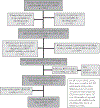Influenza Viral Shedding in a Prospective Cohort of HIV-Infected and Uninfected Children and Adults in 2 Provinces of South Africa, 2012-2014
- PMID: 29800425
- PMCID: PMC6498143
- DOI: 10.1093/infdis/jiy310
Influenza Viral Shedding in a Prospective Cohort of HIV-Infected and Uninfected Children and Adults in 2 Provinces of South Africa, 2012-2014
Abstract
Background: Prolonged shedding of influenza viruses may be associated with increased transmissibility and resistance mutation acquisition due to therapy. We compared duration and magnitude of influenza shedding between human immunodeficiency virus (HIV)-infected and -uninfected individuals.
Methods: A prospective cohort study during 3 influenza seasons enrolled patients with influenza-like illness and a positive influenza rapid test. Influenza viruses were detected by real-time reverse transcription polymerase chain reaction. Weibull accelerated failure time regression models were used to describe influenza virus shedding. Mann-Whitney U tests explored initial influenza viral loads (VL).
Results: Influenza virus shedding duration was similar in 65 HIV-infected (6 days; interquartile range [IQR] 3-10) and 176 HIV-uninfected individuals (7 days; IQR 4-11; P = .97), as was initial influenza VL (HIV-uninfected 5.28 ± 1.33 log10 copies/mL, HIV-infected 4.73 ± 1.68 log10 copies/mL; P = .08). Adjusted for age, HIV-infected individuals with low CD4 counts shed influenza virus for longer than those with higher counts (adjusted hazard ratio 3.55; 95% confidence interval, 1.05-12.08).
Discussion: A longer duration of influenza virus shedding in HIV-infected individuals with low CD4 counts may suggest a possible increased risk for transmission or viral evolution in severely immunocompromised individuals. HIV-infected individuals should be prioritized for annual influenza immunization.
Figures


Similar articles
-
Prolonged Shedding of Severe acute respiratory syndrome coronavirus 2 (SARS-CoV-2) at High Viral Loads Among Hospitalized Immunocompromised Persons Living With Human Immunodeficiency Virus (HIV), South Africa.Clin Infect Dis. 2022 Aug 24;75(1):e144-e156. doi: 10.1093/cid/ciac077. Clin Infect Dis. 2022. PMID: 35134129 Free PMC article.
-
Duration of Influenza Virus Shedding Among HIV-Infected Adults in the cART Era, 2010-2011.AIDS Res Hum Retroviruses. 2016 Dec;32(12):1180-1186. doi: 10.1089/AID.2015.0349. Epub 2016 Jun 13. AIDS Res Hum Retroviruses. 2016. PMID: 27174191 Free PMC article.
-
Predictors of influenza a molecular viral shedding in Hutterite communities.Influenza Other Respir Viruses. 2017 May;11(3):254-262. doi: 10.1111/irv.12448. Epub 2017 Mar 16. Influenza Other Respir Viruses. 2017. PMID: 28207989 Free PMC article.
-
Influenza susceptibility, severity, and shedding in HIV-infected adults: a review of the literature.Clin Infect Dis. 2011 Jan 15;52(2):219-27. doi: 10.1093/cid/ciq110. Clin Infect Dis. 2011. PMID: 21288848 Free PMC article. Review.
-
Community respiratory viruses in individuals with human immunodeficiency virus infection.Am J Med. 1997 Mar 17;102(3A):19-24; discussion 25-6. doi: 10.1016/s0002-9343(97)80005-8. Am J Med. 1997. PMID: 10868138 Free PMC article. Review.
Cited by
-
Review of the unmet medical need for vaccination in adults with immunocompromising conditions: An Indian perspective.Hum Vaccin Immunother. 2023 Aug 1;19(2):2224186. doi: 10.1080/21645515.2023.2224186. Hum Vaccin Immunother. 2023. PMID: 37402477 Free PMC article. Review.
-
High burden of viral respiratory co-infections in a cohort of children with suspected pulmonary tuberculosis.BMC Infect Dis. 2020 Dec 4;20(1):924. doi: 10.1186/s12879-020-05653-9. BMC Infect Dis. 2020. PMID: 33276721 Free PMC article.
-
COVID-19 in immunocompromised populations: implications for prognosis and repurposing of immunotherapies.J Immunother Cancer. 2021 Jun;9(6):e002630. doi: 10.1136/jitc-2021-002630. J Immunother Cancer. 2021. PMID: 34117116 Free PMC article. Review.
-
Navigating COVID-19 in the developing world.Clin Rheumatol. 2020 Jul;39(7):2039-2042. doi: 10.1007/s10067-020-05159-4. Epub 2020 May 27. Clin Rheumatol. 2020. PMID: 32462422 Free PMC article. No abstract available.
-
Prospects for SARS-CoV-2 diagnostics, therapeutics and vaccines in Africa.Nat Rev Microbiol. 2020 Dec;18(12):690-704. doi: 10.1038/s41579-020-00441-3. Epub 2020 Sep 10. Nat Rev Microbiol. 2020. PMID: 32913297 Free PMC article. Review.
References
-
- Weinstock DM, Gubareva LV, Zuccotti G. Prolonged shedding of multidrug-resistant influenza A virus in an immunocompromised patient. N Engl J Med 2003; 348:867–8. - PubMed
-
- Sato M, Hosoya M, Kato K, Suzuki H. Viral shedding in children with influenza virus infections treated with neuraminidase inhibitors. Pediatr Infect Dis J 2005; 24:931–2. - PubMed
-
- Ison MG, Gubareva LV, Atmar RL, Treanor J, Hayden FG. Recovery of drug-resistant influenza virus from immunocompromised patients: a case series. J Infect Dis 2006; 193:760–4. - PubMed
Publication types
MeSH terms
Grants and funding
LinkOut - more resources
Full Text Sources
Other Literature Sources
Medical
Research Materials

